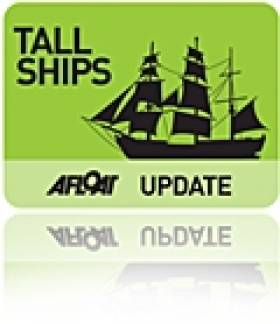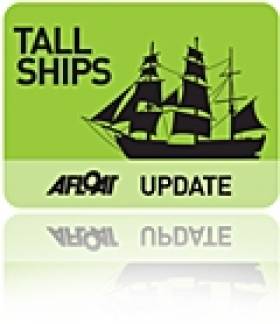Displaying items by tag: STIYD
Tall Ship Sail Training Open to All With Autumn Voyages
#TALL SHIPS - Sail Training Ireland for Youth Development (STIYD) has announced a golden opportunity for the general public to sail on a tall ship.
Hot on the heels of the Tall Ships Races visit to Dublin this August, a series of three tall ship voyages have been scheduled to take place to and from Irish ports by the UK-based Jubilee Sailing Trust (JST) on its 65-metre tall ship Tenacious between 11 October and 4 November 2012.
The first sailing from Southampton to Dublin (via Waterford) runs for 10 days from 11-20 October, followed by a seven-day jaunt from Dublin to Belfast from 22-28 October, and another seven-day trip from Belfast to Milford Haven from 29 October-4 November. Each voyage will have room for 40 trainees.
Anyone aged 16 and above can join the voyage crew as a trainee, and no previous experience is necessary.
Tenacious is also specially designed to cater for the needs of people with varying degrees of physical disability, including wheelchair users.
Features on board Tenacious and her sister ship Lord Nelson include signs in braille, lifts between decks, power assisted and 'joystick' steering, wide aisles and low-level fittings, guidance tracks and other on-deck pointers, and a speaking compass with digital screen.
STIYD says it is committed to providing access to tall ship sailing for the people of Ireland. The JST has also offered these voyages at a greatly reduced rate to encourage Irish trainees to get on board with what is hoped can become an annual event.
“It is great to see that the international tall ship fleet is reacting to recent activity in Irish sail training," said Michael Byrne, manager at STIYD. "Now that there is a central point of contact for trainees and vessel operators through STIYD, we can expect to see more and more of this kind of activity.
"When the JST approached us with a proposal to run their Irish Sea programme we offered our full support in promoting the opportunity. A unique and hugely important aspect to the JST is its ability to cater for people with varying degrees of physical ability.”
Kyle O’Regan of STIYD's youth branch added: “It is great for Irish trainees that the JST has arranged for Tenacious to have an Irish Sea programme. Being able to join or leave in your own country is a major advantage in terms of lowering costs.”
Meanwhile, the JST's Grainne Arntz said the charity has shown its "commitment to Ireland" by scheduling these autumn voyages.
"Three years ago we introduced the Ultimate Transition Year Tall Ship Adventure, a programme whereby groups of Transition Year students from Irish schools experience the challenge of tall ship sailing with diverse people.
"These voyages in the autumn will allow more groups and individuals to avail of the unique JST experience of sailing on a tall ship with people of all ages and abilities.”
The tall ship voyages are priced at £775 per person for the 10-day trip, and £525 per person for the seven-day excursions. To book your voyage with the JST visit their website HERE or call +44 23 8044 9108.
For information on the Irish branch of the Jubilee Sailing Trust visit www.jstireland.ie. For general information on sail training activities in Ireland contact Sail Training Ireland, Port Centre, Alexandra Road, Dublin 1 at 01 887 6046, e-mail [email protected] or visit www.irishsailtraining.com.
STIYD is the national sail training organisation for Ireland and is endorsed as such by Sail Training International. The vision of STIYD is to “provide access to the sail training experience for the people of Ireland”.
€10,000 Tall Ships Bursary for Irish Sailing Trainees
A new sailing body that claims it will ensure the continuation of the long standing Irish Tall Ships maritime tradition of youth sail training was launched at a ceremony in Dublin Port this afternoon.
The newly established Sail Training Ireland for Youth Development (STIYD) was officially launched by Nigel Rowe, President and Chairman of Sail Training International.Following the sinking of the Asgard II and the decision to wind up Coiste An Asgard, the future of sail training in Ireland had been uncertain but STIYD will now ensure the continuation of the long standing Irish maritime tradition. More Asgard II News.
At the launch Nigel Rowe also announced that Sail Training International had awarded STIYD with a bursary of €10,000 to help fund the participation of young Irish trainees in The Tall Ships Races 2011. Mr. Rowe remarked "It is wonderful to see Sail Training Ireland for Youth Development emerge from all the uncertainties and anxieties that followed the demise of Coiste an Asgard. The commitment and enthusiasm of the people who have made this happen will ensure its success, and they will have the full support of the international sail training community. With Waterford as a host port for this year's Tall Ships Races we have already committed more than €10,000 to help fund the participation of young Irish trainees."
The aims and objectives of Sail Training Ireland are to promote the development and education of young men and women through the Sail Training experience regardless of nationality, culture, religion, gender or social background as well as to sponsor and support sea-going trainees. Sheila Tyrrell, Chair of the steering group, who has a long history with sail training and in particular the Asgard remarked "We are delighted that we are in a position to formally launch the association, we are now taking applications for bursaries to allow young people to participate in the Tall Ships Race visiting Waterford later this year, and are also recruiting a manager to help manage the affairs of the association."
Also in attendance at the launch was Mr. Clayton Love Jnr., founding member of Coiste An Asgard and former President of the ISA. During the afternoons formalities Mr. Love Jnr. was officially awarded Honorary membership of STIYD in recognition of his outstanding contribution to sail training in Ireland.
Sail Training Ireland is also seeking to appoint a part-time manager to help with the development of a business plan and the day to day running of the organisations affairs. Further information on the position and a full job description can be found on the STI website www.irishsailtraining.com. Closing date for applications is Friday 22nd April.
The launch, sponsored by Arklow Shipping, was hosted by Dublin Port who are one of a number of ports supportive of the project.
All the latest Tall Ships News from Ireland.
Back from the deep. Should Asgard's bell ring out in Waterford? You decide. Poll.

























































